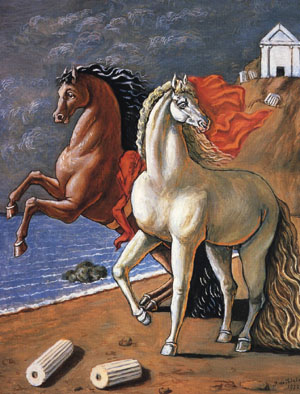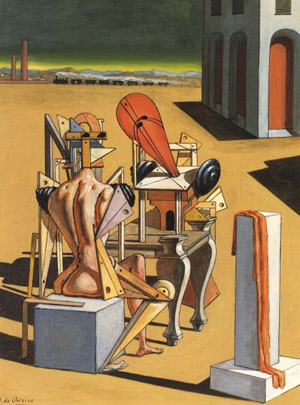Like a boomerang De Chirico's art in 1910 spins off at high speed into the unknown, the metaphysical world of Surrealism. Then after years spent spiraling back through various phases of art history, it circles into the 1970s, to end up somewhere near where it started from. This is a real bummer for art historians. The art world likes to see development by the great artists as an ever forward march of progress towards enlightenment.
De Chirico, born in Athens in 1888 of Italian parents, is one of the great enigmas of modern art. Hailed a revolutionary in 1910 and then a reactionary in 1926 by the same group of radical surrealist poets, his avant garde career was fleeting. Yet he continued to produce art to the age of 90, and in a career spanning more than 70 years, only a short, almost 10-year period, is valued by art historians. He is noted as one of the founders of Surrealism. Adding to the confusion, although financially successful throughout his career, he chose in his later years to copy his own works, backdating many of them to earlier periods.

Fortunately, recent scholarship has re-evaluated the neglected mass of De Chirico's art and several recent exhibitions have included a full range of his work. Tokyoites have the rare opportunity to experience the complete merry-go-round of De Chirico's art and life at the Bunkamura Museum of Art. You can puzzle over the many artistic conundrums while you marvel at his paintings. Curated by noted Italian scholar, Maurizio Fagiolo dell'Arco, it is an expansive exhibition of about 100 oil paintings, prints, artists' books, theater and costume designs, watercolors and drawings plus archival photographs.
Mannequins, horses, and Italian and Greek architecture of columns and arcades are the dominant motifs explored over and over in his paintings and in a variety of styles. Metaphysics, the philosophy of Nietzsche, Freudian studies of the subconscious and Classicism are the major influences on De Chirico's work. However, this is an exhibition full of surprises. Among the metaphysical constructions of robot-like faceless figures and classically prancing horses you will see copies of paintings from the Renaissance through to the Baroque.
Throughout his career, De Chirico constantly sought reinvigoration and inspiration from the art of the past and like any art school student, studied them by assiduously copying masterpieces in the great museums. Also in the surprise category at this exhibition are his paintings of Venice -- complete with gondolas and in a style reminiscent of the great Venetian painter Canaletto.

Copying your own work, however, is a little different -- especially when you backdate some of it to a period when it is seen as most influential and therefore most valuable. In this exhibition "The Muse," painted in 1972, is signed and dated 1931. The Fukuyama Museum of Art's 1972 painting, "Meeting of Two Philosophers in a Square," is a subtle re-make of De Chirico's earlier 1917 painting "The Mathematicians," now in a private collection in the US.
He began reproducing his own art as early as 1930 when the paint of the originals had barely dried. There are eighteen versions of "The Disquieting Muses," originally painted in 1917. He called these reproductions "extremely exact variations." However, this return to his most significant period -- whether purely for financial gain, to flummox the system, or for artistic re-examination and a living out of Nietzsche's theory of "eternal return," -- becomes less important as time merges both ends of his long career into a single achievement.